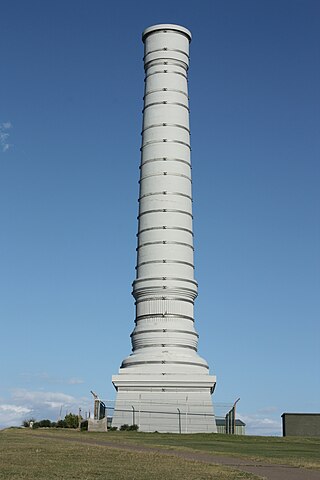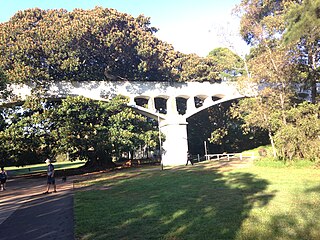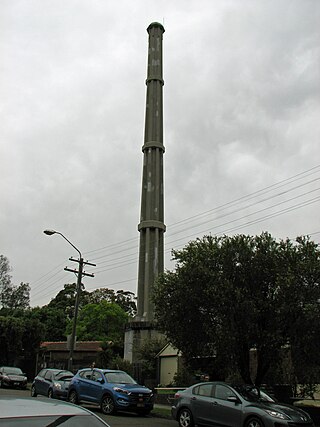
Lewisham is a suburb in the Inner West of Sydney, in the state of New South Wales, Australia. Lewisham is located 7 kilometres south-west of the Sydney central business district, in the local government area of Inner West Council.

The Hyde Park Obelisk is a heritage-listed obelisk that served as a sewer vent and is now a monument located in Hyde Park at the intersection of Elizabeth Street and Bathurst Street, in the Sydney central business district, in the City of Sydney local government area of New South Wales, Australia. It was designed and built by the NSW Department of Public Works. It is also known as The Obelisk and Obelisk Sewer Vent. It is also jokingly referred to as Thornton's Scent Bottle after mayor George Thornton. The obelisk is owned by Sydney Water, an agency of the Government of New South Wales. It was added to the New South Wales State Heritage Register on 15 November 2002.

Lewisham Sewage Aqueduct is a heritage-listed sewage aqueduct in Gadigal Reserve, adjacent to 5 Grosvenor Crescent, Summer Hill, Inner West Council, Sydney, New South Wales, Australia. It was designed by Sewerage Construction Branch and Department of Public Works and built in 1900. The property is owned by Sydney Water. It was added to the New South Wales State Heritage Register on 18 November 1999.

The Bondi Sewer Vent is a heritage-listed sewer vent shaft located at Military Road, North Bondi, Sydney, Australia. It was designed by the Metropolitan Board of Water Supply and Sewerage. It is also known as Sewer Vent (Ben Buckler), Ben Buckler and Earlier brick vent. The property is owned by Sydney Water.
The Bondi Ocean Outfall Sewer is a heritage-listed sewerage infrastructure at Blair Street, North Bondi, Sydney, Australia. The sewer line commences at the intersection of Oxford Street and College Street in Darlinghurst and then travels in a more-or-less easterly direction for 6.1 kilometres (3.8 mi) passing through a number of suburbs until it reaches Blair Street in North Bondi. It was designed and built by the Public Works Department between 1880 and 1889. It is also known as BOOS (Bondi Ocean Outfall Sewer) and Main Northern Ocean Outfall Sewer. The property is owned by Sydney Water.

Western Outfall Main Sewer is a heritage-listed former sewage farm outfall sewer and now ocean outfall sewer near Valda Avenue, Arncliffe, Bayside Council, New South Wales, Australia. It was designed by the New South Wales Department of Public Works, who built the sewer from 1895 to 1898. It is also known as SWSOOS No. 1, Western Main Carrier and Western Main Outfall Sewer. The property is owned by Sydney Water. It was added to the New South Wales State Heritage Register on 15 November 2002.

The Cooks River Sewage Aqueduct is a heritage-listed sewage aqueduct located at Pine Street, Earlwood, New South Wales, Australia. It crosses the Cooks River to Thornley Street, Marrickville. It was designed by Sewerage Construction Branch and NSW Department of Public Works and built during 1895 by J. F. Carson, contractor. The property is owned by Sydney Water, an agency of the Government of New South Wales. It was added to the New South Wales State Heritage Register on 18 November 1999.

The Wolli Creek Aqueduct is a heritage-listed sewage aqueduct located at Unwin Street, Earlwood, City of Canterbury-Bankstown, New South Wales, Australia.

The Mosman Bay Sewage Aqueduct is a heritage-listed public pedestrian bridge and sewage aqueduct at Avenue Road, Mosman in the Mosman Council local government area of New South Wales, Australia. It was designed by Sewerage Construction Branch and NSW Department of Public Works and built from 1899 to 1901 by NSW Department of Public Works. It is also known as the Aqueduct over Mosman Bay. The property is owned by Sydney Water, an agency of the Government of New South Wales. It was added to the New South Wales State Heritage Register on 18 November 1999.
Sewage Pumping Station 67 is a heritage-listed sewage pumping station located on Grand Avenue, in the Sydney suburb of Camellia, in the City of Parramatta local government area of New South Wales, Australia. It was designed and built by the Metropolitan Water, Sewerage and Drainage Board from 1929 to 1930. It is also known as SPS 67 and SP0067. The pumping station is owned by Sydney Water. It was added to the New South Wales State Heritage Register on 15 November 2002.

St Leonards Park is a heritage-listed bowling club, 15-hectare (37-acre) urban park, rugby field and cricket oval at 283a Miller Street, North Sydney, North Sydney Council, New South Wales, Australia. It was designed by William Tunks, Mayor and built during 1838. It was added to the New South Wales State Heritage Register on 31 July 2015.

The North Sydney Sewer Vent is a heritage-listed sewer ventilation stack located at the corner of Falcon Street and Warringah Freeway, North Sydney, North Sydney Council, New South Wales, Australia. It was designed and built by the Metropolitan Board of Water Supply and Sewerage. It is also known as North Sydney Sewer Vent and Alfred St Sewer Vent. The property is owned by Sydney Water, an agency of the Government of New South Wales. It was added to the New South Wales State Heritage Register on 15 November 2002.

Corunna Road Sewer Vent and Cottage is a heritage-listed sewer vent and residence at 125 Corunna Road, Stanmore, Inner West Council, Sydney, New South Wales, Australia. It was designed by the NSW Public Works Department and built by the department in 1900. It was added to the New South Wales State Heritage Register on 15 November 2002.

Premier Street Sewer Vent and Cottages is a state heritage-listed sewer vent and cottages at 24 and 26 Premier Street, Marrickville, Inner West Council, New South Wales, Australia. It was designed by the New South Wales Public Works Department, which built it from 1898 to 1900. It was added to the New South Wales State Heritage Register on 15 November 2002.

White's Creek Aqueduct is a heritage-listed sewage aqueduct at Piper Street, Lilyfield, Inner West Council, Sydney, New South Wales, Australia. It was designed by engineer William Julius Baltzer of the New South Wales Public Works Department and built by the Department from 1897 to 1898. The property is owned by Sydney Water. It was added to the New South Wales State Heritage Register on 18 November 1999.

Johnston's Creek Sewer Aqueduct is a heritage-listed sewage aqueduct located in Hogan Park, off Taylor Street, Annandale, Inner West Council, Sydney, New South Wales, Australia. It was designed by William Julius Baltzer, an engineer in the NSW Public Works Department, and built by the Department in 1897. The property is owned by Sydney Water. It was added to the New South Wales State Heritage Register on 18 November 1999.

The Trinity Uniting Church is a heritage-listed Uniting church located at 62 The Boulevarde, in the Sydney suburb of Strathfield in the Municipality of Burwood local government area of New South Wales, Australia. It was designed by George Sydney Jones & Harry Thompson and built from 1889 to 1890 by Thomas Hanley of Balmain. It is also known as Trinity Congregational Church. The property is owned by the Uniting Church in Australia. It was added to the New South Wales State Heritage Register on 19 September 2003.

The Burwood Sewer Vent is a heritage-listed sewer ventilation stack located at Railway Parade in the Sydney suburb of Burwood, New South Wales, Australia. It was designed and built by the Metropolitan Board of Water Supply and Sewerage in 1919. It is also known as Wentworth Road Sewer Vent and Railway Parade Sewer Vent. The property is owned by Sydney Water, a statutory corporation of the Government of New South Wales. It was added to the New South Wales State Heritage Register on 15 November 2002.

The Croydon Sewer Vent is a heritage-listed sewer ventilation stack located on a small parcel of land adjacent to 12 Paisley Road, Croydon, New South Wales, a suburb of Sydney, Australia. It was designed and built by the Metropolitan Board of Water Supply and Sewerage in 1922. It is also known as Sewer Vent and Paisley Road Sewer Vent. The property is owned by Sydney Water, a statutory corporation of the Government of New South Wales. It was added to the New South Wales State Heritage Register on 15 November 2002.

The Ultimo Sewage Pumping Station is a heritage-listed sewerage pumping station located at William Henry Street in the inner city Sydney suburb of Ultimo in the City of Sydney local government area of New South Wales, Australia. As a result of the construction of an elevated roadway along William Henry Street, the pumping station now fronts Pyrmont Street, with vehicles being required to enter via Quarry Street, then turning right into Pyrmont Street.




















